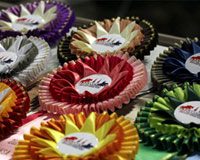 |
It can happen so quickly: You’re caught up in the joy of the moment, galloping your horse down a wide open trail, enjoying the feel of the wind in your face and the rhythmic stride of your horse beneath you. And then suddenly the footing changes and you hear the unmistakable sound of your horse’s hooves striking hard ground. If you don’t pull up and slow to a walk, you could be causing harm to your horse. There are three types of lameness that are directly associated with riding on hard ground. Equine veterinarian Jennifer Voltz and farrier Ed Baumgartner offer some insight.
A sole bruise is perhaps the most common lameness caused by hastily riding a horse over rough or rocky ground. Direct trauma to the sole causes the bruising, which makes the horse acutely lame within hours or a couple of days after the offending ride. A horse whose foot conformation places the sole of the foot close to the ground is predisposed to this lameness.
Another condition that can be caused by riding on hard ground is ringbone. Rather than coming on suddenly, the intermittent symptoms of lameness increase over time. In simplest terms, ringbone results from the buildup of excessive bony growth and bone spurs around the pastern and/or coffin joint in response to chronic trauma. Poor conformation and improper hoof trimming and shoeing can be contributing causes. But if a horse is already developing ringbone, fast work on hard or uneven ground will worsen the condition.
The third lameness that might afflict a horse is road founder. This sudden onset of laminitis can be brought on by just one extensive, animated trip over rough footing. The continual impact of hoof hitting hard ground sets up an inflammatory process inside the hoof that sets off the laminitis.
Baumgartner relates how one of his clients rode her horse in the famous Tournament of Roses Parade. The horse danced and pranced his way through the entire 5 ½ mile route that courses through the paved streets of Pasadena, Calif. By the next day, the horse was severely lame and diagnosed with laminitis or “road founder.” Although it is usually a one-time occurrence, in order to prevent a future episode the horse’s shoeing and work schedule needs to be re-evaluated.
“The next time the parade came up,” Baumgartner explained, “the horse was shod with pads. It behaved the same way, but it stayed sound and was fine because the pads helped cushion the concussion.”
The threat of these three lamenesses should be enough to make you reconsider the terrain you’re riding on. When in doubt, bring your horse down to a walk. While there’s no need to curtail your trail riding, you should take some precautions to ensure that your horse will remain sound enough to enjoy the great outdoors for years to come.






Interesting! I learned more from this article about lameness.
great article
good article. but beware, though a horse’s feet will be more protected with good shoes it is definately more prone to slip on paved roads.
Excellent advice – thank you!